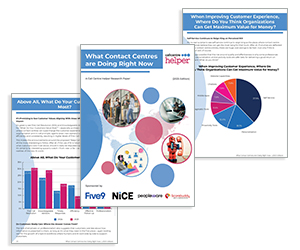The effectiveness of any resource planning strategy can be easily undermined by a series of small missteps and bad habits that routinely knock things off course.
So, what should you be watching out for to help keep things on track? We asked the experts to find out…
1. Ignoring Agent Wellbeing in the Pursuit of Efficiency

Workforce management strategies often falter not due to poor tools, but because of habits like over-prioritizing speed to answer over conversation continuity or ignoring agent wellbeing in the pursuit of efficiency.
In today’s multichannel contact centres, treating each channel in isolation leads to fragmented experiences for both customers and agents.
Leaders must shift from a mindset of “fastest first” to one focused on right-sized resourcing – balancing availability with quality.
This means designing schedules that support agent satisfaction, allowing time for training and recovery, while also ensuring customers get consistent, connected support across every interaction.
Contributed by: Tara Aldridge, Strategic Services Director, Vonage
2. Masking Problems With Operational Workarounds

Don’t mask problems with operational workarounds. If you’re constantly making ad hoc schedule tweaks (i.e. overtime / offline time), that’s not agility – it’s avoidance!
Patterns of change and disruption should lead to proper schedule redesign, not endless firefighting.
Contributed by: Lewis Gallagher, Senior Solutions Consultant, Netcall
3. Putting Off Succession Planning (and Leaving Teams Vulnerable)

Stop neglecting succession planning! When knowledge lives in the heads of a few experienced planners, teams become vulnerable.
Without a clear process for knowledge transfer, it disappears when the key people leave. This gap leads to a decline in the effective use of WFM processes and increases reliance on manual workarounds and spreadsheets.
To fix this, prioritize knowledge sharing and internal development. Identify key people as mentors, implement regular training and knowledge-sharing sessions, document key workflows, invest in upskilling your people, and plan for succession, so that knowledge is retained and expanded.
Contributed by: Zainab Ahmed, Marketing Manager, Peopleware
You can also watch the video below to hear Richard Saqladi, Regional Sales Director at Peopleware, take a look at bad habits that kill your WFM strategy and explain why contact centres need to stop leaving WFM in a silo:
4. Always Rushing to Hand Over the Plan and Start on the Next Cycle of Planning

A notably bad habit centres around what happens when you hand a plan over to be executed by operations.
Particularly when, as a workforce management team, you are working on a monthly cycle and in a rush to get things finished – instead of considering the workforce deployment plan.
Things can unravel fast! So slow down and focus on better collaboration. It’s a tricky situation to manage, but getting it right can save lots of time and stop “the blame game” in the future.
Contributed by: Keith Stapleton, Director at Select Planning Ltd
5. Applying a Single WFM Configuration Across a Global Organization

Never just apply a single WFM configuration across a global organization. These solutions should be tailored to suit the operational needs and cultural expectations of each workforce.
For example, in Germany, the concept of close monitoring is often met with resistance from workers’ councils, while in Japan, tight oversight is culturally accepted and expected.
To get it right, contact centre leaders must ensure that WFM tools are not only fit for purpose but also fully understood and embraced across teams.
Effective onboarding, role-specific training and clear success metrics, such as forecast accuracy, schedule adherence and user satisfaction, are essential.
Contributed by: Martin Taylor, Co-Founder and Deputy CEO, Content Guru
6. Fixating Too Much on Numbers, Metrics, and Budgets

It’s all too easy for resource planning teams to become fixated on things that compromise their ability to execute a great strategy.
The Problems
Fixating on a Single Number
Obsessing over one forecasted figure – like call volume or average handle time – can lead to tunnel vision.
WFM is dynamic, and success depends on understanding the full picture, not just hitting a target.
Forcing the Plan to Fit the Budget
Trying to make staffing plans align with a fixed budget, rather than operational reality, often results in under-resourcing and burnout.
Budgets should inform planning, not dictate it blindly.
Chasing Outdated Metrics
Continuing to measure success using outdated KPIs (like strict adherence or occupancy) can misguide decision-making.
Modern contact centres need to focus on customer experience, agent wellbeing, and long-term efficiency.
The Solutions
To help break these habits, leaders should look at the bigger picture instead:
- Balance data with context – Use numbers as guides, not absolutes.
- Build flexibility into budgets – Allow for scenario planning and real-time adjustments.
- Modernize KPIs – Focus on metrics that reflect today’s customer and employee expectations.
- Involve agents – Use preference-based scheduling and gather regular feedback.
- Invest in real-time tools – Empower teams to adapt quickly to change.
- Break down silos – Foster communication across departments to align goals and execution.
Contributed by: Chris Rainsforth, Director of Learning & Innovation, The Forum
7. Ignoring Agent Feedback and Compromising Morale

When agents feel unheard, morale drops and valuable insights are lost, leading to disengagement and higher turnover.
Instead, foster a culture where feedback is welcomed and acted upon. Regular check-ins, anonymous surveys, and open forums can help agents feel safe to speak up.
By valuing their input, you not only improve processes but also build trust and loyalty. Remember, a successful WFM strategy starts with making your team feel like family – heard, respected, and supported every step of the way.
Contributed by: Khalil Rellin, Vice President of Operations at SupportZebra
8. Overcomplicating Your WFM Strategy With Hyper-Specific Configurations

Leaders often overcomplicate their WFM strategies – with dozens of queues, overlapping skills, and hyper-specific configurations – thinking more detail will yield better outcomes.
In reality, this complexity undermines forecast accuracy, makes schedules harder to optimize, and inflates operational costs.
Forecasting becomes unstable when volumes are spread thin across many queues. Schedulers struggle to balance conflicting priorities. And WFM tools buckle under the weight of too many customizations.
The antidote? Simplicity. Consolidate queues where you can. Focus on core metrics that matter. Resist the urge to over-engineer.
Simplifying your WFM set-up not only improves visibility and control – it also reduces manual effort, boosts forecasting accuracy, and helps your team focus on what actually drives performance.
Sometimes, the smartest strategy is doing less, but doing it better.
Contributed by: Briana Tischner, Product Marketing Manager, Assembled
9. Getting Too Lost in the Detail to Have Real, Strategic Conversations That Matter

Be careful about how you talk to your senior leaders about resource planning. It should be seen primarily as an enabler for the strategic objectives of the organization – fundamentally to either make or save money.
That’s the bottom line, so make sure you elevate your conversations to this level. (Drilling into too much detail on forecast accuracy, SLAs, and schedule fit bypasses the strategic outcomes for the business and becomes too granular to engage senior leaders.)
Also be careful not to call it “WFM” at a strategic level as – particularly in the UK – WFM is viewed as a tactical tool for scheduling people, and the conversation is often dismissed before it even reaches the boardroom.
Contributed by: Adrian Hawes, Award Winning, Transformational Resource Planning & Contact Centre Professional
10. Always Being “Too Busy” to Upskill Your Team
If you’re not investing in your people, how can you expect them to reach their full potential?
So, spend with your team to upskill them and find out what they like to do within the WFM cycle, because when you play to their strengths and they enjoy their job, it will help you achieve your goals too (and keep good people for longer!)
Of course, there are great professional networks and training programmes out there, but don’t let tight budgets hold your team back if you don’t have the luxury of a training budget.
Join webinars, invite people in your network to host workshops, really get creative and get into the habit of bringing value and new insights into your team.
Contributed by: Arlyne Pardo, Workforce Senior Manager, DASH BPO
Workforce Management Is Not a “Set-and-Forget” Function

Workforce management is not a set-and-forget function. It’s a dynamic cycle, from strategy to real-time execution, that requires attention, alignment, and action.
Disconnection, siloed thinking and poor decision-making result in daily battles which focus on blame and “the forecast is wrong”.
Instead:
- Use long-term forecasting and strategic operating models to look 3–5 years ahead, with cross-functional alignment to budgeting and business change. WFM must influence strategy, not just respond to it.
- “Operationalizing the plan” is about collaboration. Build forecasts and capacity models with input from across the business and regularly review assumptions. Planning is a team sport.
- Invest in on-the-day playbooks, real-time dashboards, and learning loops. Understand variation, automate where possible, and shape decisions with impact across customer, commercial, and colleague outcomes.
Don’t just send out reports full of numbers, highlighting the forecast is wrong. Use the data to develop understanding and learning which informs people what they can’t see and drives better decision-making.
Contributed by: Phil Anderson, Chief Executive Officer, The Forum
For more great insights and advice from our panel of experts, read these articles next:
- How to Maintain High Quality on Self-Service Channels
- Have Wallboards Had Their Day?
- What Are Intelligent Contact Centres Doing Right Now?
- 15 Proven Tactics to Reduce Abandon Rate
Author: Megan Jones
Reviewed by: Jo Robinson
Published On: 28th Jul 2025 - Last modified: 15th Sep 2025
Read more about - Call Centre Management, Adrian Hawes, Arlyne Pardo, Assembled, Briana Tischner, Chris Rainsforth, Content Guru, Keith Stapleton, Khalil Rellin, Lewis Gallagher, Management Strategies, Martin Taylor, Netcall, Peopleware, Phil Anderson, Richard Saqladi, Scheduling, SupportZebra, Tara Aldridge, The Forum, Top Story, Vonage, Workforce Management (WFM), Zainab Ahmed








































